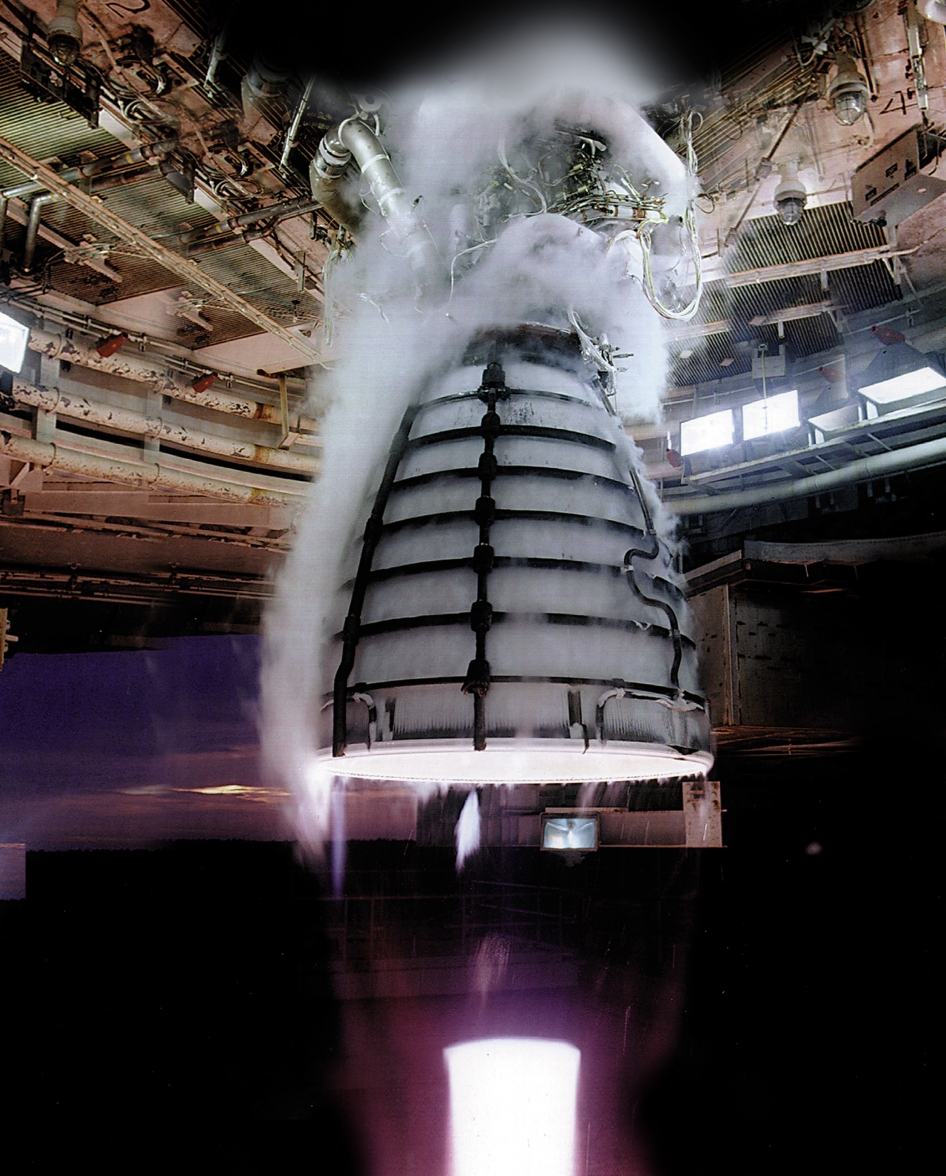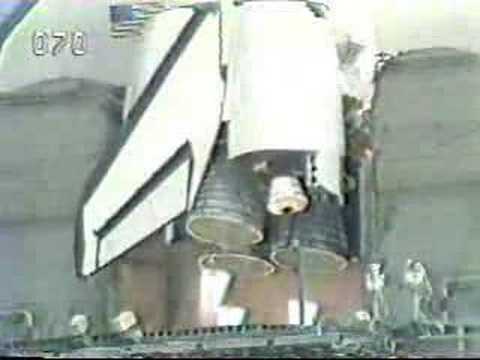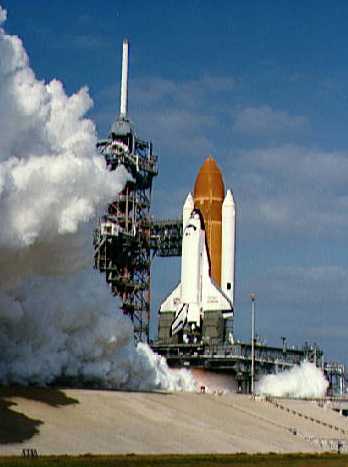
“And we have a Go for Autosequence Start. Atlantis’ on-board computers now controlling the final sequence.”
Thirty years ago, last week, NASA entered the final period before the maiden launch of its fourth space shuttle, named in honor of the world’s oldest serving oceanographic research vessel, the two-masted RV Atlantis. In time, Space Shuttle Atlantis would dwarf her oceangoing namesake’s 1.3 million miles (2.1 million km) traveled, flying no fewer than 33 missions into low-Earth orbit, voyaging 126 million miles (203 million km), and circling the Home Planet no less than 4,848 times. However, on the morning of 12 September 1985, as the spacegoing Atlantis was readied for her first flight on Pad 39A at the Kennedy Space Center (KSC) in Florida, one particularly critical milestone lay ahead. It was a milestone which would be performed seven times over the span of the shuttle era and it sought to impose launch conditions on the Space Shuttle Main Engines (SSMEs), as well as testing the orbiters’ suite of Auxiliary Power Units (APUs) in high-speed mode. Executed prior to the maiden voyage of each of the five orbiters—and on two occasions by Challenger and Discovery—the Flight Readiness Firing (FRF) was perhaps the most visible example of the behemoth straining against its shackles and yearning to fly.
“T-15 seconds … 12 … Go for Main Engine Start … ”
In a manner which had become instantly familiar over the preceding 4.5 years, ever since the first flight of the shuttle era, STS-1 in April 1981, a flurry of hydrogen burn igniters produced a shower of sparks, after which the three dark SSME bells at the extremity of Atlantis’ aft fuselage suddenly sprouted a sheet of translucent orange flame. This was quickly replaced by the striking trio of dancing Mach diamonds, as the shuttle’s on-board General Purpose Computers (GPCs) commanded the engines to full power.
“ … minus 5, 4, 3, 2, 1 … we have three engines up. Three engines up. All going well … ”
And so it was. However, as Atlantis flexed against the struts which held her, steadfast, against her rust-colored External Tank (ET) and twin Solid Rocket Boosters (SRBs), the key difference was that on 12 September 1985 she was not yet headed for space. Instead, as part of the FRF protocol, virtually all of her systems would undergo the most rigorous testing, under the closest possible conditions to actual flight, with her SSMEs fired for 20 seconds, all control elements of the Main Propulsion System (MPS) required to hold pressure in the engines and ET, the flight control instrumentation providing proper throttle and gimbal functions and validating the integrated performance of the shuttle “stack” and the compatibility of the on-board GPCs with ground-based computers.
“ … Cutoff command should be issued at this time … ”
It had been a remarkable morning; a morning whose procedures and processes had followed many of the routines which would occur on an actual launch. At T-31 seconds, the Ground Launch Sequencer (GLS) had handed over primary control of the countdown to Atlantis’ GPCs and the SRB Hydraulic Power Units (HPUs) had been activated shortly thereafter. At T-18 seconds, the SRB nozzle positions were verified and the quartet of giant “rainbirds” around the base of the launch pad were activated at T-11 seconds, ushering a flood of water to reduce the reflected energy, ahead of Main Engine Start.

As vast clouds from the engines obscured Pad 39A and drifted upward into the clear blue Florida sky, the shutdown commands were issued. The SSMEs fell silent after a perfect test. “Our Flight Readiness Firing is completed,” it was announced. “All three engines came up. We ran for the full planned duration of this test. All preliminary indications would be we had a completely successful test this morning.” Not for another three weeks, until 3 October 1985, would Atlantis’ SSMEs again roar to life … and on that occasion, they would do so with five humans aboard and with the intention of spearing into space.
Yet the roar of Atlantis’ engines, that September morning, 30 years ago, was not the first occasion on which a shuttle had shaken the marshy Florida landscape, without actually leaving the ground. The first FRF took place on 20 February 1981, in the run-up to STS-1, the first orbital voyage of the shuttle program, as Columbia stood on Pad 39A, and was labeled as the “Wet Countdown Demonstration Test (WCDT)/Flight Reading Firing (FRF).” Key aims were to test the complete shuttle system—Columbia, her ET, and SRBs—“in a real-time launch countdown which will culminate in the firing of the orbiter’s three main engines and a simulated launch to insure their proper integration prior to the STS-1 flight.” Fundamentally, the FRF sought to “verify the capability of the launch facility to provide propellants to the shuttle under launch conditions,” with the ET and SRB stack “exposed to the same thermal environment they will experience during STS-1 launch preparations.” All MPS control elements were “required to maintain pressure in the External Tank and in the main engines during the test firing as they would during an actual launch,” whilst the ability of the APUs, hydraulic systems, and flight controls were verified as being able to throttle the three SSMEs at between 94 and 100 percent, as well as gimbaling them to effect steering.
When 20 February 1981 came around, the six-day WCDT was nearing its conclusion and would culminate in the FRF. In readiness for the test firing, launch controllers started the countdown clock at T-53 hours, when they powered up the SRBs, the Ground Support Equipment (GSE), and the shuttle’s on-board systems. Four seconds prior to the simulated liftoff, Columbia’s SSMEs roared to life at 120-millisecond intervals, reaching 90 percent of rated performance within three seconds and hitting 100 percent precisely at T-0. Three seconds later, engineers simulated the retraction of the ET umbilical and the SRBs’ hold-down posts; and after 15 seconds of stable thrust from the SSMEs, shutdown commands were issued to the engines. The test was a great success and cleared another critical milestone, ahead of the STS-1 launch.
One significant aspect of the FRF was to evaluate and measure the effect of the “twang”—the amount of movement in the orbiter, against the rest of the stack, during the SSME ignition sequence—and in the case of Columbia this induced a forward shift by about 25.5 inches (64.7 cm), which was somewhat greater than the 19 inches (48.2 cm) predicted. However, the twang remained within anticipated structural limits. Also, the spark-like hydrogen burn igniters were started at the same time as SSME ignition, but post-FRF analysis led to a decision to initiate this sequence at T-4.4 seconds ahead of Main Engine Start on STS-1 and all subsequent missions.

By the time the next FRF occurred at 11 a.m. EST on 18 December 1982, Columbia had flown five missions and her sister orbiter, Challenger, was approaching her maiden voyage. However, as circumstances transpired, Challenger became the only vehicle to undergo two FRFs in the same mission processing flow. Drawing close parallels with STS-1, Challenger’s systems were powered up and at the 60-second mark the Public Affairs Officer (PAO) picked up the final coverage: “T-1 minute and counting … the firing system that releases the sound suppression water onto the pad has been armed … T-50 seconds and counting … T-45 seconds and counting … T-40 seconds and counting; SRB development flight recorders are being turned on … T-37 … gaseous oxygen vent arm will not be retracted on this particular test … T-31 seconds, we have a Go from LPS [Launch Processing System] for auto-sequence start … [Challenger’s] four primary flight computers taking over control of the terminal count … final LPS command for engine start will occur at approximately 10 seconds … T-15 seconds and counting … ”
At this stage, the relative silence on the pad changed markedly. Firstly, the sound suppression system gushed water across the launch pad. “T-10 … Go for Main Engine Start … we have Main Engine Start … ” as the now-familiar sheet of orange flame gave way to a trio of shock diamonds from the three main engines, combined with a thunderous roar and vast cloud of smoke. The engines ignited in a ripple-like sequence, starting up at 120-millisecond intervals, reaching 90 percent of rated performance within three seconds and hitting 100-percent at zero: “T-0, engines throttled at 100 percent, all engines up and burning … T+5 seconds, engines continuing to burn … T+10 seconds … twelve … first [engine] cutoff at T+15 seconds … [Number One] engine cutoff … and engines Two and Three also cutoff at 16.8 seconds … T+25 seconds; GLS safing now in progress … ” However, the FRF was not yet over, for the APUs were run up to T+2 minutes in high-speed mode, after which GLS safing of the vehicle was completed.
According to NASA Launch & Landing Operations Director Al O’Hara, it was anticipated that about 48 hours after the test, by 20 December, the initial data was expected to be in place, after which the actual physical inspection of the SSMEs could commence. In the immediate aftermath of the FRF, O’Hara described it as “a resounding success,” but it later became clear that everything did not run according to plan. “Let me caution you that this is based upon the real-time information from the firing room and from the support rooms that we got on-net about 30 minutes after T-0,” he told journalists later that morning. “So as the day progresses and more information get available, that may change.”
Indeed it did.
During the test, engineers detected levels of gaseous hydrogen in the shuttle’s aft compartment which grossly exceeded allowable limits. When it proved impossible to pinpoint the cause or location of the leak, the Mission Management Team (MMT) elected to perform a second FRF. New instrumentation was installed inside and outside Challenger’s aft fuselage to better determine if the leakage was from an internal or external source, with suspicion initially focusing on the latter possibility, because vibration and current had found their way behind the SSMEs’ heat shields. Extra sensors and a higher-than-ambient pressurization level were installed to prohibit penetration by “external” hydrogen sources and the second FRF, lasting 23 seconds, took place on 25 January 1983. It too revealed high concentrations of hydrogen gas, necessitating the replacement of one of the SSMEs and, subsequently, the replacement of the other two engines, due to detection of cracked welds, fractured fuel lines and generic “seepage” in an inconel-625 tube within the ignition system. Described by NASA Associate Administrator for Space Flight James Abrahamson as “a real detective job,” a third FRF was briefly considered, but by mid-February and the identification of the leak source this ultimately proved unnecessary.
A year later, in the spring of 1984, two more orbiters—Discovery and Atlantis—neared completion and headed into their own processing flows for their maiden voyages, capped by their own FRFs. As will be discussed in tomorrow’s AmericaSpace history article, these firings added valuable new data and experience to engineers’ understanding of SSME functionality. Moreover, beyond the opening flights of Discovery and Atlantis, an additional two FRFs would also be performed before the end of the shuttle era: one in the weeks prior to STS-26, the first post-Challenger mission, and another to herald the career of the newest orbiter, Endeavour.
The second part of this article will appear tomorrow.
Want to keep up-to-date with all things space? Be sure to “Like” AmericaSpace on Facebook and follow us on Twitter: @AmericaSpace





Congratulations! CEFAB – Centro Experimental de Foguetes Aeroespaciais da Bahia